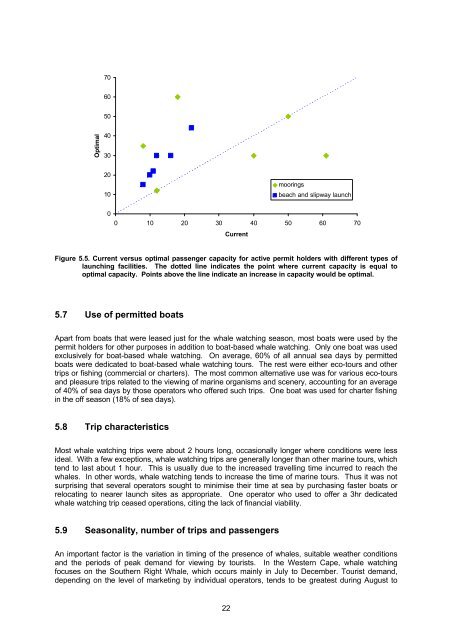Download PDF (2.5MB) - Anchor Environmental
Download PDF (2.5MB) - Anchor Environmental
Download PDF (2.5MB) - Anchor Environmental
Create successful ePaper yourself
Turn your PDF publications into a flip-book with our unique Google optimized e-Paper software.
70<br />
60<br />
50<br />
Optimal<br />
40<br />
30<br />
20<br />
10<br />
moorings<br />
beach and slipway launch<br />
0<br />
0 10 20 30 40 50 60 70<br />
Current<br />
Figure 5.5. Current versus optimal passenger capacity for active permit holders with different types of<br />
launching facilities. The dotted line indicates the point where current capacity is equal to<br />
optimal capacity. Points above the line indicate an increase in capacity would be optimal.<br />
5.7 Use of permitted boats<br />
Apart from boats that were leased just for the whale watching season, most boats were used by the<br />
permit holders for other purposes in addition to boat-based whale watching. Only one boat was used<br />
exclusively for boat-based whale watching. On average, 60% of all annual sea days by permitted<br />
boats were dedicated to boat-based whale watching tours. The rest were either eco-tours and other<br />
trips or fishing (commercial or charters). The most common alternative use was for various eco-tours<br />
and pleasure trips related to the viewing of marine organisms and scenery, accounting for an average<br />
of 40% of sea days by those operators who offered such trips. One boat was used for charter fishing<br />
in the off season (18% of sea days).<br />
5.8 Trip characteristics<br />
Most whale watching trips were about 2 hours long, occasionally longer where conditions were less<br />
ideal. With a few exceptions, whale watching trips are generally longer than other marine tours, which<br />
tend to last about 1 hour. This is usually due to the increased travelling time incurred to reach the<br />
whales. In other words, whale watching tends to increase the time of marine tours. Thus it was not<br />
surprising that several operators sought to minimise their time at sea by purchasing faster boats or<br />
relocating to nearer launch sites as appropriate. One operator who used to offer a 3hr dedicated<br />
whale watching trip ceased operations, citing the lack of financial viability.<br />
5.9 Seasonality, number of trips and passengers<br />
An important factor is the variation in timing of the presence of whales, suitable weather conditions<br />
and the periods of peak demand for viewing by tourists. In the Western Cape, whale watching<br />
focuses on the Southern Right Whale, which occurs mainly in July to December. Tourist demand,<br />
depending on the level of marketing by individual operators, tends to be greatest during August to<br />
22
















